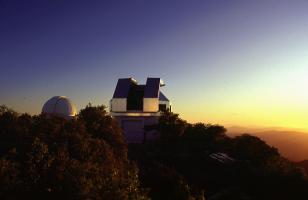
Alabama
Florence
University of North Alabama Telescope Viewing
256-765-4284
Shows offered Tuesday and Friday nights. Viewings still available with planetarium presentations.
$3 per person
Arizona
The WIYN telescope at sunset. [NOAO/AURA/NSF]
Tucson
Kitt Peak National Observatory Nightly Observing Program
520-318-8726
Every night of the year except July 15-September 1
This program offers views through a 20-inch and two 16-inch reflecting telescopes, and includes an introductory presentation and a light dinner. Visitors also have binoculars to use while not looking through the telescopes.
$48 adults, $44 seniors 62 and over, students, and current military (with ID). Group rates available.
Kitt Peak National Observatory Public Nights on WIYN Telescope
520-318-8726
Every night of the year except July 15-September 1. Provided transportation departs at 4 pm.
This program offers views through a 36-inch research telescope. The program includes transportation to the site from the University of Arizona campus in Tucson, dinner, and an introductory presentation.
$120 per person
Pima College East Campus Observatory Open House
520-206-7610
Monday through Friday during the regular school semester
Telescope viewing offered.
Free admission
Flaundrau’s Observatory Telescope Viewing
520-621-STAR
Wednesday through Saturday, excluding holidays
Viewing through a 16-inch telescope offered.
Free admission
Arkansas
Conway
University of Central Arkansas Public Nights
501-450-5900
Third Wednesday of every month
Stargazing through a 14-inch reflector at the University’s observatory
Free admission
California
Berkeley
Lawrence Hall of Science Saturday Night Stargazing
510-642-5132
Third clear Saturday of every month
Stargazing through telescopes provided by amateur astronomers, plus lessons on how to navigate the night sky.
Free admission
Fresno
Downing Planetarium Star Gazing
559-278-4121
Stargazing is available through a single telescope every Friday night that the planetarium is open.
$5 adults, $2.50 children and students
Los Altos Hills
Foothill Observatory Public Viewing
650-949-7334
Every Friday
Views through 16-inch telescope offered
Free admission, $2 parking fee
Los Angeles
Griffith Observatory Star Parties
213-473-0800
One Saturday a month
Several telescopes available, provided by Los Angeles Astronomical Society and the Los Angeles Sidewalk Astronomers.
Free admission
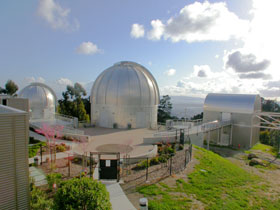
The telescope domes at Chabot Space and Science Center. [Conrad Jung]
Oakland
Chabot Space and Science Center Telescope Viewing
510-336-7300
Every Friday and Saturday evening, every Saturday and Sunday afternoon
Nightime and daytime viewing through several telescopes, including a new 36-inch reflector.
Free admission
Pasadena
Mount Wilson Observatory 60-Inch Telescope Viewing
Available most nights of the year
The largest telescope in the world when it was dedicated in 1908, this century-old instrument is now dedicated to public viewing for groups of 1-25. A session director and telescope operator are included as part of the fee.
$1,700 full night
San Jose
Lick Observatory Summer Visitors Program
408-274-5061
Every other Friday night, late June through mid-September
After talks by two research astronomers and a presentation on the history of Lick Observatory, visitors look through the 36-inch Great Lick Refractor and the 40-inch Nickel Telescope.
$5 per person
Lick Observatory Music of the Spheres
Every other Saturday night, late June through mid-September
Concert and a talk by a research astronomer is followed by viewing through the 36-inch Great Lick Refractor and, conditions permitting, the 40-inch Nickel Telescope.
$35-$150 per person, depending on package
Colorado
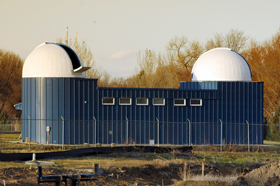
Little Thompson Observatory
Berthoud
Little Thompson Observatory
303-871-5172
Every third Friday night
Viewing through an 18-inch telescope, on the grounds of Berthoud High School.
Admission is free
Boulder
University of Colorado Sommers-Bausch Observatory
303-871-5172
Every Friday the University of Colorado is in session
Viewing through 16-inch, 18-inch, and smaller telescopes.
Admission is free
Denver
University of Denver Chamberlin Observatory
303-492-6732
Every Tuesday and Thursday
Programs include talks, tours of the historic observatory, and viewing through the 20-inch Alvan Clark refractor, installed in 1894.
Admission is $3 for adults, $2 for children
Gunnison
Gunnison Valley Observatory
970-642-1111
Every Friday and Saturday night during summer
Viewing through a 30-inch reflector, the largest public telescope in Colorado
Recommended donation is $5 for adults, $3 for children
Connecticut
Danbury
Western Connecticut State University Starwatch
203-837-8672
One night per month during spring and fall sessions
Viewing through a 20-inch reflector at the University’s campus observatory.
Free admission
Middletown
Van Vleck Observatory
401-364-9508
Every Wednesday during academic year
Viewing through 24-inch reflector, 20-inch Alvan Clark refractor, others; on the campus of Wesleyan University
Free admission
District of Columbia
Washington, DC
National Air & Space Museum Public Viewing
202-633-2214
Programs offered every Wednesday and Saturday from 1 – 3 pm through a 16-inch telescope, which monitors the sun and the phases of Venus.
Free admission
Florida
Cocoa
Astronaut Memorial Planetarium and Observatory
321-433-7373
Every Friday and Saturday evening.
Viewing through a 24-inch Ritchey-Cretien telescope.
Free admission, although there is a charge for the planetarium and IMAX movies.
Davie
Buehler Planetarium & Observatory
954-201-6315
Every Wednesday, Friday, and Saturday
Public viewing through the Broward Community College Observatory.
Free admission
Miami
Weintraub Observatory Telescope Viewing
305-646-4200
First Friday of every month
Viewing through two Meade telescopes is offered.
Free admission
Orlando
Orlando Science Center Telescope Viewing
407-514-2000
Every Friday and Saturday evening
Viewing through a 10-inch telescope offered.
Free with museum admission
St. Petersburg
St. Petersburg College Telescope Viewing
727-341-4320
Three Fridays a month during the summer.
Viewing is offered through several telescopes before the planetarium show.
Free admission
Georgia
Atlanta
Fernbank Observatory Public Nights
678-874-7102
Every Thursday and Friday
Public viewing through a 36-inch reflector.
Free admission
Columbus
Coca-Cola Space Science Center Astronomy Nights
706-649-1470
One or two nights per week
Star parties offer views through a 16-inch telescope and other instruments at several parks in the Columbus area.
Free admission, although the parks may require a parking fee.
Macon
Museum of Arts and Sciences Weekly Telescope Viewing
478-477-3232
Every Friday night.
Several telescopes are avaliable for viewing.
Free with museum admission
Young Harris
Young Harris College Public Observation
(706) 379-5130
Every Friday evening during the school year
Viewing through a Cassegrain telescope offered.
Free admission
Hawaii
Honolulu
Bishop Museum Telescope Viewing
808-848-4168
First and third Fridays of each month
Telescope viewing is avaliable after Planetarium show.
$6 adults, $4 ages 4-12; cash only.
Mauna Kea
Mauna Kea Visitors Information Station Nightly Star Gazing
808-961-2180
Available every night of the year
The visitor center for the telescopes at Hawaii’s Mauna Kea, including the giant twin Keck Telescopes, offers views through small telescopes until 10 p.m. the program includes a documentary on the mountain’s cultural and research heritage.
Free admission
Idaho
Mountain Home
Bruneau Dunes Observatory Programs
208-366-7919
Every Friday and Saturday evening, mid-March through October
Idaho’s largest public observatory offers viewing through several telescopes.
$3 ages 6 and up, plus $5 per vehicle park admission
Twin Falls
Centennial Observatory Open House
208-732-6666
Second Saturday of every month
Viewing through a 24-inch telescope (fully wheelchair-accessible).
Free admission
Illinois
Elizabeth
Stargazing at Apple River Fort
815-858-2014
Once a month during the summer
Telescope viewings and stargazing, accompanied by American Indian stories.
Free admission
Indiana
Indianapolis
Butler University Telescope Viewing
800-368-6852
Most Friday and Saturday evenings
Telescope viewing is avaliable after a planetarium show.
$3 adults; $2 children, students and seniors; $7 families of five or less
Iowa
Cedar Falls
University of Northern Iowa Observatory
Thursday nights during fall and spring semesters
A variety of telescopes; McCollom Science Hall, UNI campus
Free admission
Cedar Rapids
Palisades-Dows Observatory
319-848-2068
At least one Saturday night per month, March-November
A variety of telescopes; at Palisades State Park
Kansas
Louisburg
Powell Observatory
913- 438-3825
Every Saturday night, May-October
A variety of telescopes, including a 30-inch reflector
Recommended donation $6 adults, $4 children
Topeka
Crane Observatory
785-670-2264
First and third Thursday of the month during fall, spring semesters
On the campus of Washburn University
Free admission
Wichita
Lake Afton Public Observatory
316-978-7827
Every Friday and Saturday
Varying astronomy presentations followed by 16-inch telescope viewing
$5 adults, $3 children 6-12, children under 6 free
Kentucky
Golden Pond
Golden Pond Observatory Telescope Viewing
270-924-2020
Open March – October 7 days a week, 5 days/week in November, 4 days/week in December.
Viewings through four telescopes and one Hydrogen-Alpha refractor.
Free admission
Louisiana
Baton Rouge
Highland Road Park Observatory Public Nights
225-768-9948
Every Friday and Saturday
Public viewing through several telescopes.
Free admission
Maine
Fairfield
Northern Stars Planetarium Star Parties
207-453-7668
Customer Request
Telescope viewing and star parties for private parties, offering viewing through six telescopes of up to six inches.
$175 per star party
Orono
Maynard F. Jordan Observatory Telescope Viewing
207-581-1341
Friday and Saturday evenings, September–April
Viewing through an 8-inch refractor built Alvan Clark & Sons offered.
Free admission
Maryland
Dundalk
Community College of Baltimore County Star Parties
443-840-5939
Every other Friday
Star parties offer views through a 14-inch telescope.
Free admission
Massachusetts
Boston
Museum of Science: Stargazing at the Observatory
617-589-0267
Fridays from early March to late September, 8:30-10 p.m.
Public viewing through an 11-inch reflector atop the museum’s parking garage.
Free admission
Michigan
Ann Arbor
Angell Hall Observatory Open House
One or two Fridays per month Public viewing is offered through a 16-inch reflector and several smaller instruments at this facility on the University of Michigan campus. Open houses are also held in conjunction with special public lectures and planetarium shows.
Free admission
Bloomfield Hills
Cranbrook Institute of Science ‘Starry Nights’
248-645-3200
Shows offered Friday evenings, 8:30-10 p.m.
Public viewing is offered through a 6-inch refractor in the Institute’s public observatory.
Requires museum admission
Dexter
Peach Mountain Observatory Open House
Two Saturdays per month during warmer weather
Hosted by a local astronomy group, this University of Michigan facility offers viewing through a 24-inch telescope, plus those set up by the astronomy club.
Free admission
East Lansing
Michigan State University Observatory Public Observation Nights
517-355-4672
One Friday and Saturday per warmer month
Public Observation Nights offer views through a 24-inch telescope, with additional, smaller telescopes avaliable.
$2 for children, $2.50 for students and seniors, $3 for adults
Minnesota
Chaska
Onan Observatory Star-Gazing Nights
Varying dates, depending on season and sky events
A variety of telescopes; at Baylor Regional Park
$5 per vehicle parking fee
Minneapolis
University of Minnesota
Every Friday during fall and spring semesters
Public viewing atop the physics building on campus
Free admission
Saint Paul
Macalester College
Every other Thursday
Viewing through a 16-inch telescope
Free admission
Mississippi
French Camp
Rainwater Observatory and Planetarium
662-547-6482
Second Friday of every month
Viewing through a variety of telescopes
Call for rates
Missouri
Columbia
Laws Observatory
Every Wednesday
A 16-inch telescope, atop the Astronomy and Physics Building, University of Missouri-Columbia
Free admission
Fayette
Morrison Observatory
660-248-6371
Thursday nights during Central Methodist University terms
A historic Alvan Clark & Sons reflecting telescope
Free admission
Saint Louis
UM-St. Louis Schwartz Observatory
One Saturday night per month, March-November
A variety of telescopes; at North Campus, near the Fine Arts Building
Free admission
Wentzville
Astronomical Society of Eastern Missouri
Every Friday night
A variety of telescopes; at Broemmelsiek Park
Free admission
Montana
Bozeman
Stars Over Bozeman
One Friday night each month during summer
At Gallatin Regional Park, hosted by Southwest Montana Astronomical Society.
Free admission
Nebraska
Lincoln
Hyde Memorial Observatory Telescope Viewing
402-441-7895
Viewing offered through 8-, 12.5-, and 14-inch telescopes every Saturday night
Free Admission
Nevada
Carson City
Western Nevada College Jack C. Davis Observatory
801-587-7223
Every Saturday night.
Free admission
Reno
University of Nevada, Reno MacLean Observatory
First Friday of every month.
Public viewing through 14- and 22-inch telescopes
Free admission
New Hampshire
Concord
McAuliffe-Shepard Discovery Center
603-271-7827
First and second Friday of the month
Viewing through several telescopes
Free admission
Durham
University of New Hampshire Observatory
First and third Satury of every month
Viewing through several telescopes
Free admission
Hanover
Shattuck Observatory
603-646-2854
Fridays during the school term
On the campus of Dartmouth University
Free admission
New Jersey
Cranford
William Miller Sperry Observatory Public Nights
908-276-7827
Every Friday
Two informal talks are followed by public viewing through 24-inch and 10-inch reflectors.
Free admission
New Mexico
Albuquerque
University of New Mexico Campus Observatory
505-277-2073
Every Friday during the fall and spring semesters
Public viewing through a 14-inch telescope
Recommended donation is $5 for adults, $3 for children
Chaco Canyon (Aztec, Farmington)
Chaco Culture National Historical Park Night Sky Programs
Friday and Saturday evenings in April and October; Tuesday, Friday, and Saturday evenings May through September.
The programs begin with staff presentations on archaeoastronomy and cultural history, followed by telescope viewing.
$8 per vehicle park entry fee
New York
Vestal
Kopernik Observatory Telescope Viewing
607-748-3685
Open every Friday night, March – November
Viewing through several telescopes — amateur and professional — offered.
$3 per child, $5 per adult, $16 maximum per family
North Carolina
Brevard
Evenings at PARI
828-862-5554
Second Friday of each month
Viewing through several telescopes after public talk and tour of Pisgah Astronomical Research Institute, a radio observatory; in the Pisgah National Forest
$20 adults, $10 children 14 and under, $15 students and seniors
Chapel Hill
Morehead Planetarium and Science Center
919-962-1236
One Saturday per month
Viewing through several telescopes; at Jordan Lake State Recreation Area, south of Chapel Hill
Free admission
Ohio
Bay Village
Lake Erie Nature & Science Center Telescope Viewing
440-871-2900
First and third Saturdays of every month
Public viewing through several telescopes after the Center’s 8 p.m. planetarium show.
Free admission
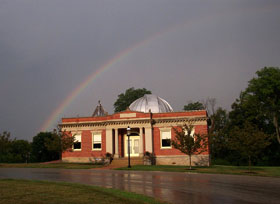
The Cincinnati Observatory Center. [Cincinnati Observatory Center]
Cincinnati
Cincinnati Observatory Center Astronomy Nights
513-321-5186
The oldest professional observatory in the United States offers views through two historic telescopes on its astronomy nights, including a 16-inch refractor built by Alvan Clark and Sons and an 11-inch refractor that was built in 1842. Tickets include a tour of the Observatory and an astronomy lecture.
Thursday shows, suggested donation of $4 per person, Friday shows are $6 for adults, $4 for children. Not available first Thursday and Friday of each month, reservations required for all programs.
Delaware
Perkins Observatory Evening Public Programs
740-363-1257
Every Friday night, except July
Star parties include viewing through the 32-inch Schottland Telescope, which is the Observatory’s primary research and teaching telescope, and smaller instruments. Other features include lectures and Observatory tours.
$7 adults, $5 children 3-17, $5 seniors (ages 62 and over) (advance purchase only; if space is available, tickets are available at the door for $2 more)
Toledo
Brooks Observatory Star Parties
800-586-5336
Every Friday evening.
Viewing through two 10-inch and one 6-inch telescope.
Free admission
Wilmot
The Wilderness Center Telescope Viewing
330-359-5235
First Friday of every month
Viewing through a 16-inch and two 10-inch telescopes offered.
Free admission
Oklahoma
Norman
University of Oklahoma Campus Observatory
Every Wednesday when the university is in session
Free admission
Oregon
Bend
Pine Mountain Observatory
541-382-8331
Every Friday and Saturday, late May through September
Public viewing through a 32-inch and other telescopes
Recommended donation is $5 per person
Oregon City
Haggart Observatory
509-594-6044
One Saturday per month
Viewing through 24- and 13-inch telescopes
Free admission
Portland
OMSI Star Parties
503-797-4000
One Saturday per month, plus other dates
Viewing through a variety of telescopes at both Rooster Rock State Park (east of Portland) and L.L. “Stub” Stewart State Park (west)
$5 per vehicle park entry fee
Sunriver
Oregon Observatory
541-593-4394
Various nights, depending on season
Viewing through several telescopes
$6 adults, $4 children 12 and under
Pennsylvania
Allentown
Lehigh Valley Amateur Astronomical Society Public Star Parties
610-797-3476
One Saturday per month, see website for dates.
An astronomy lecture and planetarium show are followed by skywatching through the society’s telescopes.
$2 donation recommended for adults
Latrobe
St. Vincent College Telescope Viewing
724-532-6600
Mondays and Wednesdays throught the school year
10-inch telescope viewing avaliable after planetarium show.
Free admission
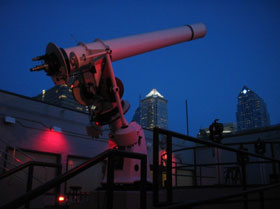
The Philadelphia skyline stands behind one of the Franklin Institute telescopes.
Philadelphia
Franklin Institute Night Skies in the Observatory
215-448-1200
Second Thursday of every month
Viewing through five different telescopes offered.
$5 admission, free for Franklin Institute members
The Philadelphia skyline stands behind one of the Franklin Institute telescopes.
York
York County Astronomical Society Public Observation
717-578-9109
Once a month throughout the year
Viewing through the club’s telescopes offered and star charts avaliable.
Free admission
Rhode Island
Charlestown
Frosty Drew Nature Center and Observatory
401-364-9508
Every Friday
Viewing through 16-inch reflector, other telescopes
Recommended donation $1
North Scituate
Seagrave Memorial Observatory
Every Saturday
Viewing through four telescopes, including 16-inch reflector, 8-inch Clark refractor
Free admission
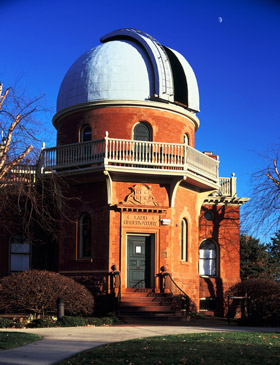
Ladd Observatory, Providence
Providence
Ladd Observatory
401-863-2323
Every Tuesday
On the campus of Brown University
Free admission
Warwick
Margaret M. Jacoby Observatory
Every Wednesday
Viewing through a 16-inch reflector, on the campus of Community College of Rhode Island
Free admission
South Carolina
Aiken
Ruth Patrick Science Education Center Observatory
Every Saturday after planetarium show
Viewing through several telescopes; on the campus of University of South Carolina
Free admission
Columbia
Melton Memorial Observatory
Every Monday
On the campus of University of South Carolina Aiken
Free admission
Florence
Francis Marion University Observatory
One or more Saturdays per month
Viewing through several telescopes
Free admission
Tennessee
Nashville
Sudekum Planetarium Star Parties
615-862-5160
About once a month
Star Parties offer views through several telescopes, and visitors are welcome to bring their own.
Free admission
Texas
Austin
University of Texas Public Viewing Nights
512-471-5007
Wednesday, Friday, and Saturday nights when the University is in session
Viewing through a 16-inch telescope atop RLM Hall on Wednesday nights, and through a 1930s-vintage 9-inch telescope atop Painter Hall on Friday and Saturday nights.
Free admission; $3 parking in University garages after 6 p.m.
Burnet
Eagle Eye Observatory Star Parties
512-334-2070
Open one Saturday a month for public star parties
Public viewing is offered through 16-inch and 12.5-inch reflectors at this site, which is operated by the Austin Astronomical Society in conjunction with the Canyon of the Eagles Lodge and Nature Reserve in the Texas Hill Country.
Free admission for lodge and reserve guests
Fort Bend
George Observatory: Saturdays at the George
713-639-4708
Every Saturday, 3-11 p.m.
Public viewing through 36-inch, 18-inch, and 14-inch reflecting telescopes operated by the Houston Museum of Natural History on the grounds of Brazos Bend State Park.
$5 per person, plus park admission fee
Fort Davis
McDonald Observatory Star Parties
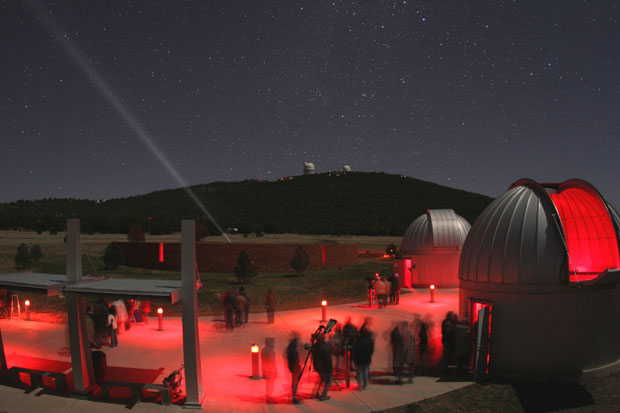
Visitors attend a McDonald Observatory star party. [Frank Cianciolo]
Every Tuesday, Friday, and Saturday
In addition to naked-eye tours of the night sky, the star parties offer views through a 22-inch telescope, a 16-inch telescope, and several smaller instruments.
$12 adults, $8 children 6-12, $40 family (five or more). $60 per person for 107″ viewing.
Also available as part of a combination ticket that includes daytime Observatory tours.
432-426-3640
McDonald Observatory Public Viewing Nights
Dates and starting times vary; check the web site for schedules
McDonald Observatory offers views through the 107-inch Harlan J. Smith and 82-inch Otto Struve telescopes one or more nights per month. Programs include dinner and a presentation by a research astronomer. The Observatory also offers viewing through the 36-inch research telescope, but this program does not include the presentation are dinner. Reservations are generally required several months in advance. Not suitable for children under 10.
$75 per person for the 107-inch and 82-inch telescopes, $50 for the 36-inch telescope
432-426-3640
Fort Worth
Fort Worth Noble Planetarium Star Parties
817-255-9300
Once a month during the summer
Star Parties offer viewings through several telescopes and interaction with Fort Worth Astronomical Society members.
Free admission
San Antonio
Scobee Planetarium Telescope Viewing
210-486-0100
No shows currently listed.
Utah
![Full Moon over Bryce Canyon [National Park Service]](https://stardate.org/wp-content/uploads/2010/05/fullmoonoverpowelptandkev.jpg)
Full Moon over Bryce Canyon [National Park Service]
Bryce Canyon
Bryce Canyon National Park Night Sky Programs
801-587-7223
1-3 nights per week, depending on the season
Telescope viewing and multimedia presentations. Other astronomy programs include solar viewing three times per week and an annual star party.
$25 per vehicle park admission fee
Salt Lake City
University of Utah South Physics Observatory
801-587-7223
Every clear Wednesday evening
On the roof of the South Physics Building
Free admission
Vermont
Middlebury
Middlebury College Observatory
802-443-2266
A few warm-weather nights during the year
Viewing through several telescopes
Free admission
Virginia
Charlottesville
Leander McCormick Observatory Public Nights
434-243-1885
First and third Friday of each month (except holidays)
Established in 1885, the Observatory offers views through a 26-inch refractor built by Alvan Clark and Sons and a modern 10-inch reflector. The program includes a tour of the Observatory and audio-visual presentations.
Free admission
Fan Mountain Public Nights
434-243-1885
Twice yearly, in April and October
This University of Virginia observing station offers views through 40-inch and 31-inch reflectors. Advance tickets are required.
Free admission
National Radio Astronomy Observatory Star Parties
304-456-2150
Once a month, April – December
NRAO volunteers provide telescopes for celestial viewing.
Free admission
Fairfax County
Analemma Society’s Star Parties
703-503-4648
Every Friday night during the summer
Viewing through several telescopes offered.
Free admission
Newport News
Abbitt Observatory Daily Telescope Viewing
757-595-1900
Daily access offers viewing through four telescopes and two sun-spotting devices.
Free with museum admission
Washington
Goldendale
Goldendale Observatory
509-773-3141
Every Wednesday through Sunday, April through September
Public viewing through a 24.5-inch and other telescopes; daytime programs available as well, offering telescopic views of bright stars or planets. Operated by Washington State Parks
Admission via state parks pass
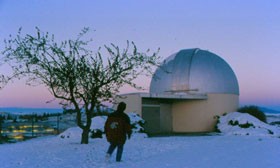
A winter evening at Washington State University’s Jewett Observatory.
Pullman
Washington State University Star Parties
509-335-4994
Approximately once a month
Viewing through 12-inch Alvan Clark & Sons telescope.
Free admission
Wisconsin
Madison
Washburn Observatory Open House
608-262-8544
Every Wednesday during the summer. First and third Wednesdays of each month year-round.
Observatory open for public viewing.
Free admission
Stevens Point
UW-SP Observatory Telescope Viewing
715-346-2208
Three days a week, during the school year
Viewing through a 0.4-meter telescope offered.
Free admission